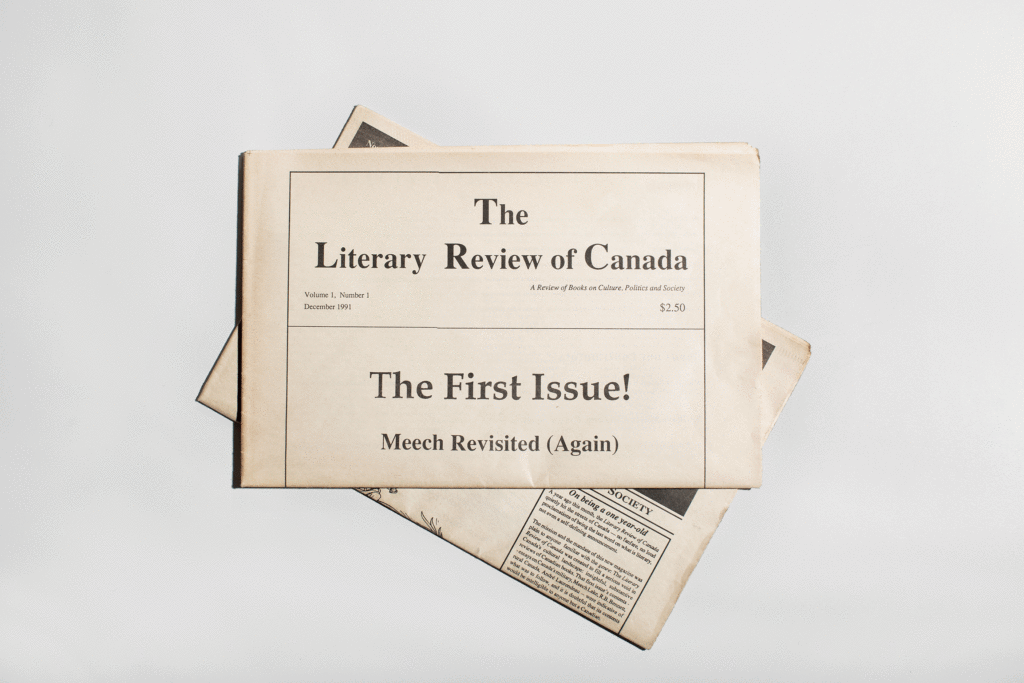The Literary Review of Canada announced “The First Issue!” in December 1991 with confident, unadorned typography, a four-column grid, and simple house ads inviting readers to “treat yourself to the best discussions of Canadians.” The second issue, two months later, described itself on the back page as “what you thought was always needed!!”
As an undergraduate English major at the University of Nebraska–Lincoln, I learned a valuable lesson in editorial restraint: You have three exclamation points to use in your entire life. Use them wisely. It’s a maxim I generally embrace, but I happily forgive my predecessors for spending the LRC’s allotment in those early days. I also admit to using more than my share of exclamation when the magazine offered me the opportunity to help shape “the best discussions” of today.
The Literary Review of Canada was created to fill a serious void in Canada’s cultural landscape: insightful, substantive reviews of Canadian books….Born the child of a severe economic crisis, and of a time when the American newspaper USA Today can boldly advertise itself on Canadian street boxes as “the national daily” without even raising eyebrows, the possibilities of survival for a Canadian monthly dedicated to the exploration of the Canadian mind seemed slim.
However slim the margins of survival were then, the magazine and the cultural space it covers would soon have to reckon with a radical destabilization of print media and unimaginable redistribution of ad revenue—a continuing upheaval felt by legacy and upstart publications alike. Yet survive the LRC has, sometimes narrowly, because “our pages feed the need to discover more about the intellectual richness that is Canada.” With fewer and fewer places to look for smart analysis on the wide variety of books an ever wider variety of Canadians write, those words are even truer today.

While the LRC has changed over the years, its mandate remains the same.
Bryan Dickie
No one can deny the vehicles with which we might connect thoughtful readers, from coast to coast to coast, with our nation’s intellectual richness have changed. And no one can deny the LRC hasn’t stayed up-to-date with the latest models.
Physical books and magazines fill my house and mailbox, but I also engage with The New York Review of Books, Vanity Fair, The Walrus, The New Yorker, and many others through the various screens that punctuate my day. I am not one to read James Meek’s fascinating but lengthy review of Alan Rusbridger’s Breaking News on my phone, but I am keenly aware of it because I follow the London Review of Books on Instagram.
The LRC, on the other hand, is not what one would describe as an early adopter: The magazine’s website, reviewcanada.ca, got going in September 2001; our pages didn’t mention the URL in print for another two years. Though the site has evolved since then, the magazine’s web and social media presence are rather tired. But in the months to come, we will, like Rip Van Winkle with an iPhone, gradually awaken to the twenty-first century in thoughtful, sustainable ways that complement the physical magazine that graces your coffee table and stands proudly tall on the newsstand. If we do it right, with the resources we have, even more readers may “come to depend on the Literary Review of Canada as a guide to our symbols.”
The tools have changed since the early 1990s, but my editorial brief remains more or less the same: To reflect deeply on books and other texts that nourish Canadian life. Not to break news, but to provide relevant cultural context that helps us make sense of the news that is broken. To hold up a mirror, as best as space and other constraints allow, to the widest possible range of Canada’s intellectual output.
I am deeply humbled to add my name to the list of LRC editors—from Patrice Dutil to Sarmishta Subramanian—who have shaped an indispensable forum for discussion in this country. While my name appears in this issue, all of the credit goes to interim editor Murray Campbell, who has kept the magazine going these past few months with the help of a dedicated team of staff and supporters. You are holding in your hands—or reading on your screen, perhaps—the product of their commitments and intellectual toil. Because of them, I can confidently say the Literary Review of Canada will survive the coming year—a promise not unlike the one made in November 1992 and honoured ever since. And that calls for an exclamation point!
Kyle Wyatt is the editor-in-chief of the Literary Review of Canada.

